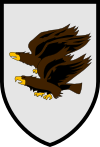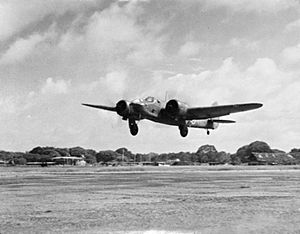No. 11 Squadron RAF facts for kids
Quick facts for kids No. 11 Squadron RAF |
|
|---|---|

Squadron badge
|
|
| Active | |
| Country | |
| Branch | |
| Type | Flying squadron |
| Role | Multi–role combat |
| Part of | No. 1 Group RAF |
| Home station | RAF Coningsby |
| Motto(s) | Ociores acrioresque aquilis (Latin for 'Swifter and keener than eagles') |
| March | Marching Through Georgia |
| Aircraft | Eurofighter Typhoon FGR4 |
| Battle honours |
|
| Insignia | |
| Squadron tail badge |  |
| Squadron badge heraldry | Two eagles volant in pale, commemorating the unit's First World War operation of two-seater fighter-reconnaissance aircraft, eagles being chosen to symbolise speed and strength. Approved by King George VI in May 1937. |
| Squadron roundel |  |
| Squadron Codes | DA-DZ |
No. 11 Squadron, also known as XI Squadron, is a very old and important part of the Royal Air Force. It's known as "the world's oldest, dedicated fighter unit." This means it was one of the first groups of pilots whose main job was to fly planes that fought other planes.
The squadron started way back in 1915 as part of the Royal Flying Corps. Over the years, it has flown many different types of aircraft. It used to fly the Tornado F3 until 2005. Then, in 2006, it started flying the Typhoon F2, which is a modern and powerful jet.
Contents
History of No. 11 Squadron
World War I: The First Fighter Squadron
No. 11 Squadron of the Royal Flying Corps was created in Wiltshire, England, on February 14, 1915. Its job was to fly "fighting duties." In June, it received two-seater Vickers Gunbus planes. These planes were sent to France on July 25, 1915. This made No. 11 Squadron the first group of pilots fully equipped with fighter planes to be sent into battle.
The squadron's Gunbusses quickly went into action. On July 28, 1915, Captain Lionel Rees achieved the squadron's first air victory. He forced a German observation plane to land. Later, on November 7, 1915, Second Lieutenant G. S. M. Insall earned a Victoria Cross. This is a very brave award. He forced down and destroyed a German plane.
The Gunbus planes soon became old-fashioned. They were replaced by Royal Aircraft Factory F.E.2b planes in June 1916. Later, in August 1917, the squadron started using Bristol Fighters. These planes were used to patrol over German areas and attack targets on the ground. The squadron was closed down at the end of 1919.
Many skilled pilots, called flying aces, were part of No. 11 Squadron during World War I. This included Victoria Cross winner Lionel Rees and other famous pilots like Andrew Edward McKeever and Albert Ball VC. The two eagles on the squadron's badge, given in 1937, represent the two-seater fighter planes they flew in this war.
Between the World Wars: New Planes and New Places
No. 11 Squadron started up again in January 1923. It became a bomber squadron, flying Airco DH.9A planes. They soon moved to RAF Bircham Newton in England. In April 1924, they got Fairey Fawn planes, which weren't much better.
In November 1926, they received Hawker Horsley planes. In December 1928, the squadron moved to Risalpur in India (now Pakistan). There, they flew Westland Wapiti planes. Their job was to help the army and carry out air raids against tribal groups.
In February 1932, they switched to Hawker Hart planes. On May 31, 1935, a big earthquake hit the city of Quetta. No. 11 Squadron helped with the rescue efforts. In July 1939, the squadron received Blenheim I bombers. They moved to Singapore the next month, just before World War II began in Europe.
World War II: Fighting Across the Globe

In April 1940, the squadron moved to India. They were then sent to Aden because war with Italy seemed likely. The first Blenheim planes arrived in Aden on June 19, 1940. This was nine days after Italy declared war on Britain. The squadron flew its first combat mission of the war on the same day.
No. 11 Squadron was very busy in the early part of the Eastern Africa campaign. They attacked Italian targets. In December 1940, the squadron moved to Egypt. They supported a British attack called Operation Compass.
In January 1941, the squadron was sent to Greece. They fought in the Greek Campaign against the Italians. They also got newer Blenheim IV planes. On February 28, 1941, a strong earthquake hit Larissa, damaging the airfield. Squadron members helped rescue people.
In April 1941, Germany invaded Yugoslavia and Greece. No. 11 Squadron attacked German troops. But by April 16, they had to retreat. The remaining planes and crews were moved to Crete and then to Egypt. They rebuilt their strength in Palestine and were ready for action again by May 28, 1941.
After rebuilding, the squadron fought in the Syrian Campaign against the French. They attacked airfields. In August 1941, the squadron moved to Iraq. On August 26, they took part in an operation to protect oilfields for the Allies. They even dropped leaflets.
Later, the squadron moved to Colombo, Ceylon in early 1942. They attacked Japanese ships there. In 1943, the squadron switched to Hurricanes. They moved to Burma to support the Fourteenth Army by attacking ground targets.
By January 1943, most of the aircrews in the squadron were from Australia. No. 11 Squadron was one of the few RAF squadrons to fight against Italian, German, French, and Japanese forces.
Since 1945: From Jets to Typhoons
After World War II, the squadron was part of the forces in Japan from 1945 to 1948. It then closed down. It started up again in Germany in October 1949. They flew Mosquitos, Vampires, and Venoms. The squadron closed again in 1957.
In January 1959, it reformed with Meteor night fighter planes. A year later, Javelins replaced the Meteors. The squadron was based in West Germany until it closed again in 1966.
No. 11 Squadron reformed in early 1967. For the next 21 years, they flew Lightnings. By May 1988, they were one of the last two squadrons using this aircraft.
From August 1988, the squadron flew the Panavia Tornado F3. In 2003, some of their Tornado F3s were changed to carry ALARM missiles. This allowed them to attack enemy air defenses. In October 2005, the squadron closed down again.
The RAF announced that No. 11 Squadron would be the second squadron to get the Eurofighter Typhoon. It would be based at RAF Coningsby. The squadron officially started up again on March 29, 2007. It became the RAF's main Typhoon multi-role squadron.
In March 2011, No. 11 Squadron helped patrol the no-fly zone over Libya. This was part of Operation Ellamy. In 2013, the squadron went to Cyprus to help with air defense.
In February 2018, the squadron took part in Exercise Red Flag 18-1. This is the world's largest air combat exercise. The squadron's Typhoons flew from Nellis Air Force Base in Nevada, USA.
Aircraft Flown by No. 11 Squadron
No. 11 Squadron has flown many different types of aircraft throughout its history:
- Vickers E.S.1 (1915–1915)
- Vickers FB.5/FB.9 (1915–1916)
- Bristol Scout (1915–1916)
- Nieuport 16/17 (1915–1916)
- Royal Aircraft Factory F.E.2b (1916–1917)
- Bristol F.2b (1917–1919)
- Airco DH.9A (1923–1924)
- Fairey Fawn (1924–1926)
- Hawker Horsley (1926–1928)
- Westland Wapiti (1928–1932)
- Hawker Hart (1932–1939)
- Bristol Blenheim Mk I/Mk IV (1939–1943)
- Hawker Hurricane Mk II (1943–1945)
- Supermarine Spitfire Mk XIV/Mk XVIII (1945–1948)
- de Havilland Mosquito FB.VI (1948–1950)
- de Havilland Vampire FB.5 (1950–1952)
- de Havilland Venom FB.1/FB.4 (1952–1957)
- Gloster Meteor NF.11 (1959–1962)
- Gloster Javelin FAW.4/FAW.5/FAW.9 (1959–1966)
- English Electric Lightning F.3/F.6 (1967–1988)
- Panavia Tornado F3 (1988–2005)
- Eurofighter Typhoon (2007 – present)
Images for kids
-
Aircraft at St. Omer, France, 19 December 1917. The aircraft on the right is a Bristol Fighter (thought to belong to No. 11 Squadron) and on the left is a Royal Aircraft Factory S.E.5.
-
RAF personnel rolling a 250lb bomb for loading onto Hawker Hurricane Mk II.C Hellzapoppin of No. 11 Squadron, at Sinthe, Burma in the early 1940s.
-
A No. 11 Squadron English Electric Lightning F.3 on display at the 1976 International Air Tattoo at RAF Greenham Common.
-
Panavia Tornado F3 in No.11 Squadron markings, seen at RAF Waddington in 1992.
-
A Eurofighter Typhoon FGR.4 of No. 11 Squadron at RAF Coningsby in 2012.
See also
- List of Royal Air Force aircraft squadrons









